
It is funny how current COVID conditions can change a trip, not only for us but for a lot of others travelling state to state. The plan was to head across the Northern Territory’s Plenty Highway to remote areas of Queensland, but, with a border closure, this wasn’t going to happen.
The Plenty Highway is notorious for its remote 500km meandering route and for being as corrugated as hell, with bulldust holes big enough to swallow anything in their path. Not really suitable for caravans, the Plenty often sees 55-metre-long road trains and is closed when the rivers flood, often for days at a time.

These days the Plenty is sealed for nearly 100km – from its starting point on the Stuart Highway 70km north of Alice Springs, across to Ovgeva Creek – but when we first tackled it a few years ago, it was an all-dirt narrow track and took several days. It used to be just a cattle property access road from western Queensland to the NT, but the road has improved for the general public and is slowly being upgraded.
Even though the Plenty has a State Route number (12), it’s still classed as a medium to hard track. Not because of any tyre-shredding hill climbs or winching sections, but due to the extreme remoteness of the area, and there are only a couple of spots where you can get fuel and camp.
From the Stuart Highway turn-off, the Plenty heads eastward passing through several stunning mountain ranges to Queensland, all heavily signposted and almost impossible to miss.
Gemtree
With our plans in disarray, we decided to still head along the Plenty but instead explore the mountains, fossick for gems and hit part of the iconic Binns Track.
Our first stop was just 70km along the Plenty at Gemtree, a place packed full of history, with its own store, fuel storage, caravan park and fossicking tours.
Wind the clock back to 1885 – just a few years after explorer Charles Stuart passed through – and David Lindsay surveyed the country between the Queensland border and the Overland Telegraph Line, which is around where the highway runs north-south.
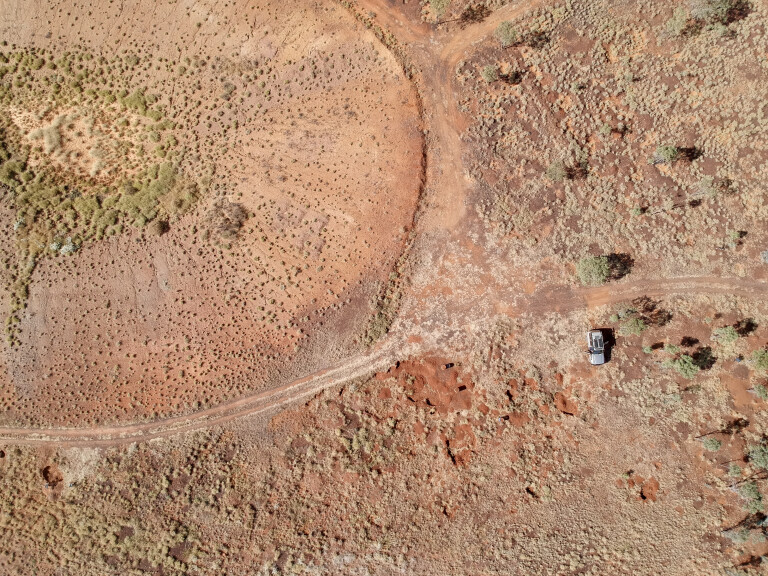
A year later, gold was found east at Arltunga but ran out after 30 years, while huge amounts of mica were found at the same time. Keep in mind this was just before Alice Springs (originally called Stuart) was settled.
Over the next few years, 15 stations were taken up with pastoral leases where the present day Gemtree Park is, even property monger Sidney Kidman owned several stations nearby.
Times were tough back then, and just trying to survive due to the lack of water was the biggest concern. One station that had the Hale River passing by was named The Garden. Here, they grew crops to feed the nearby goldfields and to supply trade to the other stations.
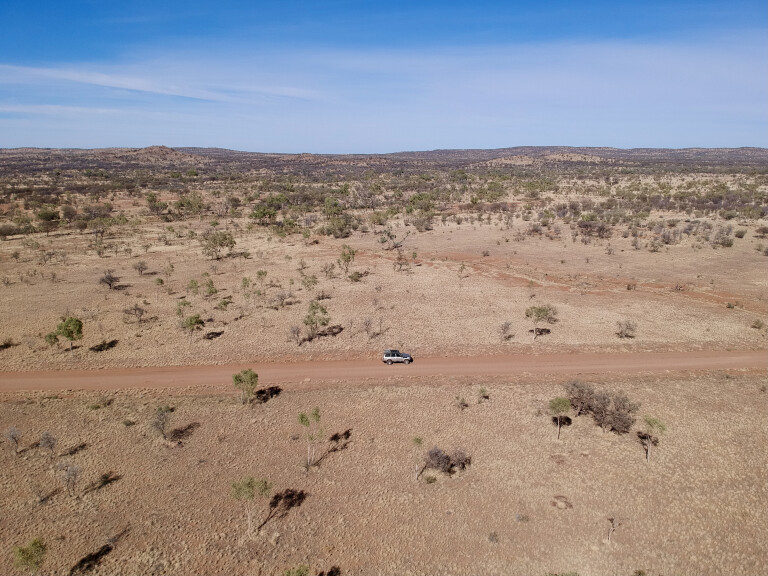
Another station, Yambah, had a home-made drilling rig that was hauled by 13 mules and, in the early years, sunk 27 bores to the depth of 300 feet, only finding water in two of them. Yambah Station had one of the first dams in the Red Centre, eventually running cattle, which it still does today, with some of the best cattle in the Territory.
At Gemtree is an original cottage from Mt Riddock Station dating back to 1928, which has been preserved and turned in to an historical museum containing an array of unbelievable history. There’s more than 100 years of family and station history listed, from early establishment through to good times, the extreme hardships and property maps from the early pioneers.
There’s a small shop, and if you’re hungry, try one of Gemtree’s home-made pies – they are to die for.
Mud Tank camp
Our camp destination was another 30 minutes to the east, just off the Binns Track, where you can free camp at the Mud Tank Zircon Field fossicking area.
This is true bush camping at its finest on Alcoota Station, with stunning views of the Harts Range Group to the south. There are no facilities, so you need to be totally self-sufficient within native bush and grasslands.

When surveyor, David Lindsay, was exploring the area in 1885, he found what he thought were rubies, and the story goes that a ruby rush happened here, but later it was realised these red stones were only garnets. In its heyday, more than 300 people trekked from Oodnadatta on foot to seek their fortunes, only to be disappointed with the sporadic gold activity at the time.
Today, the Mud Tank Zircon Field is on most fossickers’ bucket lists, with garnets and zircons that have been in the ground for millions of years. Most are alluvial (found just under the surface), so around the free fossicking area are dozens of shallow pits where people have been chipping away at the banks looking for coloured stones.
The zircons range in colours, from clear and white through to pink, and are similar to Argyle diamonds, just not as hard or expensive. One thing to keep in mind when finding zircons is that they have been crafted by nature and not man-made (i.e. cubic zirconia), so you’re the first person to ever lay eyes on it.
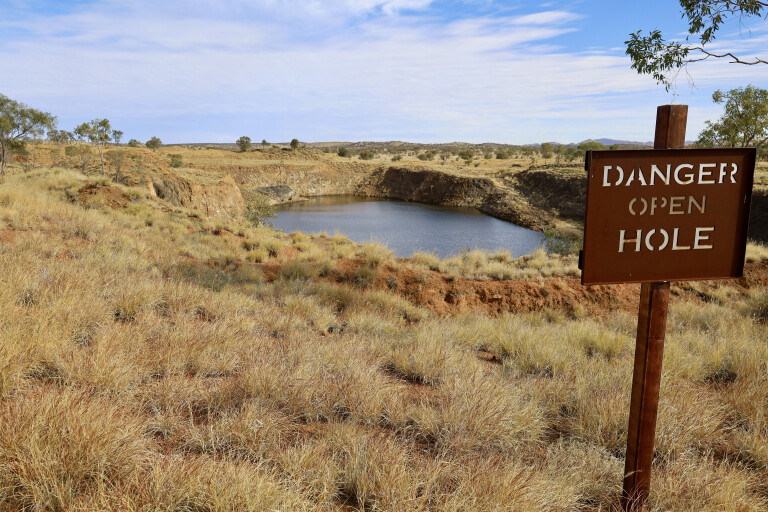
In the late 1880s, mica was found in sheets in the nearby areas. Mica is a mineral that is soft, often very flaky and is used in make-up, cement, the wrap that covers electrical equipment, and as a heat-resistant material. Back in the day between 1880 and the close of the industry in 1960, nearly all Australian mica came from this area.
A five-minute drive from the fossicking area leads to an old open-cut mica mine. While partly full of mineral-tainted water, the enormity of the mine can be viewed from several different spots. It’s hard to say how much came out of this one single pit, but the nearby tailing dumps give a suggestion it was significant for this area.
Mica was in demand during WW2 for use as heat shields, but by 1950 demand slowed and cheaper sources were found elsewhere.
The mining here brought a diverse range of nationalities to the area, namely Italians, creating foundations for today’s multicultural community at nearby Alice Springs.
Binns Track
If fossicking for a few days doesn’t reap any reward, the nearby Binns Track is a good way to get out and about.
It might take 10 days to complete the entire Binns Track – which starts at the NT-SA border and travels for more than 2220km north – but doing this section is simply stunning. Created by NT ranger Bill Binn, it was his dream for tourers to pass through remote and interesting areas including desert fringes, historical areas and mining sections, through to the north where barra can be caught.
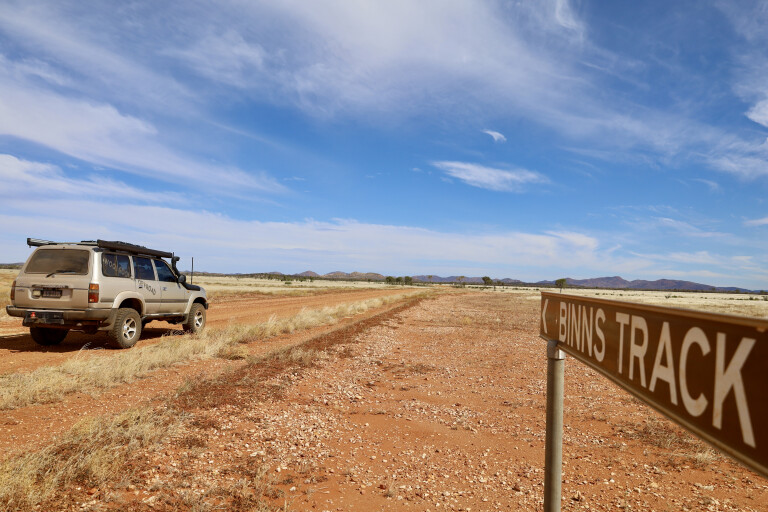
This section starting at the Zircon fields (and well-signposted) heads south and is named ‘Section Two – East MacDonnells’. Also named The Pinnacle Track, its 40km length is diverse, meandering across the landscape where it connects with Gardens Road. We departed early in the morning, when the sun was highlighting the different colours on the jagged rocky range in front of us.
The first part of the Binns Track runs through Alcoota Station, which covers an impressive 3000km². A working cattle station, it has also had significant fossil finds. Found back in 1962, an eight million year-old megafauna area was discovered, covering an area two football fields in size. Once a large basin, they’ve found huge mammal wolf-like creatures, wombats as large as cars, and many birds.
As with most outback or remote public roads that pass through stations, there’s no permission to leave the road unless you have a permit or the go ahead from the owner. When doing this section, there’s no reason to anyway, as the views are spectacular from the road.
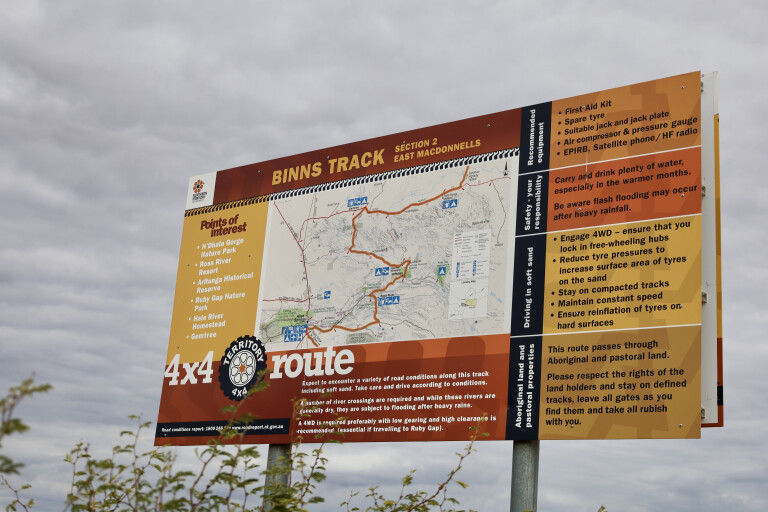
The track isn’t overly difficult in the dry, but it’ll be a different story in the wet – with a couple of creek crossings and a section where the water obviously uses the road as a run-off. One section enters Aboriginal land and the signs are quite clear not to leave the road. Remember to leave the gates as you find them.
Binns Track will finally meet up with the Garden Road, and by turning left it’ll take you through Arltunga, Ross River and back to Alice or the southern part of the Binns Track towards the border.
Our option was to turn right towards the Stuart Highway along the Garden Road and loop back along the Plenty Highway. The sections along Binns and the Garden Road only took an hour each to fully enjoy the scenery, but it’s a great way to get away from camp.
This section of the Harts Range is certainly an eye opener and, if you have the time, spend more than a few days here to truly understand the area.
5 things to see and do
01: PLENTY HIGHWAY
The Plenty Highway runs east for around 500km from the Stuart Highway, 70km north of Alice Springs, to the Queensland border, then becomes the Donohue Highway with another 250km to Boulia. Only the first 100km of the Plenty has blacktop, and it’s dirt and bulldust for the rest of the way. It’s among the most remote highways in the country, and the best time to traverse it is during the dry season from May to October.
02: GEMTREE
Still on the sealed section of the Plenty Highway is the Gemtree Roadhouse and Caravan Park, incorporating a History Museum and award-winning Campoven Kitchen among the attractions. Caravan park accommodation includes sites, rooms and cabins, and booking is essential.
03: MUD TANK ZIRCON FIELD
Access is from the Plenty Highway some 8km east from Gemtree. Turn right at Mud Tank Bore, follow the signs indicating the zircon fields, and try your luck at finding some fantastic and colourful zircon semi-precious gemstones.
04: THE OUTBACK WAY
The Plenty Highway forms part of The Outback Way tourist route. The Outback Way is a series of roads and tracks that stretches for 2700m from Laverton, Western Australia, to Winton, Queensland, via the Red Centre. It’s remote touring at its finest.
05: FREE CAMPING
You can free camp at the Mud Tank Zircon Field fossicking area on Alcoota Station. With no facilities, you need to be totally self-sufficient, camping within native bush and grasslands with stunning views of the Harts Range Group to the south.

COMMENTS